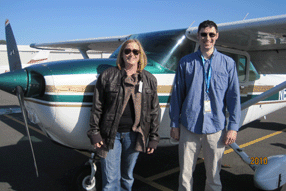
The club provides an ideal environment for student and certificated pilots to learn, featuring top-notch instructors, well-maintained aircraft, affordable rates, and members with a diverse range of skills and experience who can support your learning. You can also gain hands-on experience with maintenance activities, such as changing the oil or tires.
Is the San Francisco Bay Area a good place for me to learn how to fly?
- The Bay Area is an excellent place to learn how to fly!
- Training here is more thorough, given the diversity of terrain, airspace, and airports.
Do you know someone who can teach me how to fly?
- Yes! We have many members who are instructors and are available to help you achieve your aviation goals.
What sort of training is available?
- Training is available for the “Private Pilot - Airplane, Single Engine, Land (ASEL)” certificate and many more advanced certificates and ratings, including:
- Instrument Rating – Airplane
- Commercial Pilot, ASEL
- Certified Flight Instructor (CFI)
How do I become a private pilot?
- Complete the membership application to join the club.
- Complete ground school and pass a written exam on aeronautical knowledge.
- Complete the Pre-Solo Written Exam.
- Take flying lessons and pass a flight test, which includes an oral exam.
- You may take your flying lessons at the same time as you attend ground school so that the ground school will make more sense.
- You must have passed the written exam before you can take the flight test.
Where can I attend ground school?
- There are multiple online options available, including:
How long will it take me to become a private pilot?
- It depends on how frequently you fly and how fast you learn.
- You must complete a minimum of 40 flying hours, learning and demonstrating various requirements, such as night, instrument, and cross-country flying.
- Almost everybody needs 60 to 70 hours to master all the skills.
How frequently should I fly to become a private pilot?
- It is best to fly two or three times per week. More than that, and you may get burned out. Less, and you may forget what you learned, having to backtrack and repeat previous activities.
- You will need to set up a schedule that works for both you and your instructor.
How much will it cost me to become a private pilot?
- Flying is not inexpensive, but it is worth every penny!
- About half of your flying time will be with an instructor, and the other half will be by yourself.
- The instructors set their rates, and some may start as low as $50 per hour.
- You may spend twice as many hours with an instructor as you do flying because of pre- and post-flight reviews and ground sessions.
- See our aircraft for their hourly rates.
Do I need to purchase an insurance policy?
- No. Our insurance policy carries the following endorsement:
- STUDENT PILOT SUPERVISION ENDORSEMENT
This policy is amended as follows: Coverage shall not apply to any insured while any aircraft covered under this policy is being operated by a student pilot unless said student pilot is under the direct supervision of a properly qualified FAA certified flight instructor who shall have specifically approved each flight undertaken by the student prior to take-off.
- STUDENT PILOT SUPERVISION ENDORSEMENT
- To ensure we are fully compliant with this endorsement, the club requires:
- All instructor signoffs for student solo flight to include a requirement for the student to communicate the specific details of each solo flight undertaken to the instructor and to receive an approval prior to initiation of the flight.
- The approval should be in a recorded form (text, email, Foreflight etc.).
- No student solo flight may be undertaken without having specific approval for that flight from the student’s instructor.
- Note there is no requirement for the instructor to be physically present to supervise, review, or approve the flight.
What happens after I earn my private pilot certificate?
- You fly, Fly, and FLY!!!
- Once you have obtained your pilot certificate, it remains valid for life.
- You can pursue advanced certificates and ratings up to Airline Transport Pilot.
- You should occasionally fly with an instructor to maintain your skills.
Where can I find additional policies, procedures, and regulations related to instruction, flight operations, and certification?
- See Bylaws and Rules for club-specific information.
- See Members Only for club- and KOAK-specific information.
- See Federal Aviation Regulation (FAR), Part 61 for FAA-related information, including:
